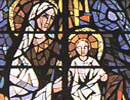
 "The Parish is the home of brotherhood made welcoming by Charity."
"The Parish is the home of brotherhood made welcoming by Charity."John Paul II to the Torre Spaccata community
Diocese of Rome
St. MARIA REGINA MUNDI
Carmelite Friars of the Italian Province
![]() Hello! This is a brief introduction to our parish church and to our official parish website for all our non-Italian speaking visitors. It wasn't possible to translate all of the contents and the websites, so all the links that you find on this page will lead to other pages of the website in Italian.
We apologize for this.
Hello! This is a brief introduction to our parish church and to our official parish website for all our non-Italian speaking visitors. It wasn't possible to translate all of the contents and the websites, so all the links that you find on this page will lead to other pages of the website in Italian.
We apologize for this.
THE PARISH CHURCH OF St. MARIA REGINA MUNDI
 The Parish Church St. Maria Regina Mundi is in Italy, in the Diocese of Rome and it has been entrusted to a Carmelite Friars community of the Italian Province since 1961.
The Parish Church St. Maria Regina Mundi is in Italy, in the Diocese of Rome and it has been entrusted to a Carmelite Friars community of the Italian Province since 1961.The devotion to our Lady of the Mount Carmel (or of Carmine) takes its origin from the holy mountain in Palestine, place of the prophet Elias’s deeds, and home for many hermits during the centuries.
Between 1206 and 1214 St. Albert, Patriarch of Jerusalem, gave a formula of life to the Latin hermits dwelling on the Mount Carmel, near the “Elias’s spring”.
OUR PARISH CHURCH
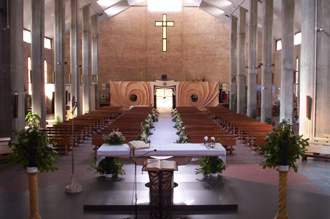 The big parish church was blessed and inaugurated by the vicar-cardinal of Rome, Angelo Dell’Acqua, on February 21st 1970.
The big parish church was blessed and inaugurated by the vicar-cardinal of Rome, Angelo Dell’Acqua, on February 21st 1970.For its architectural lines and in its proportions the parish church gains the greatness of a sanctuary; its capacity is of more than 500 people sitting and it was designed by the architects Eugenio Montuori and Giuseppe Nicolosi.
On the left hand-side of the church stands the bell tower (30 metres high). On the same side there is the baptistery, now changed into a welcome centre.
On the right hand-side there is the parish house with different offices on the groundfloor and the priests’ rooms on the upper floor.
The interior of the church, divided into three aisles, is characterized by structures in reinforced concrete and brick walls. The central aisle is 68.85 metres long and 25.52 metres large and 19 metres high.
The lantern, of the square dome, reaches a height of 24 meters, while the facade is 21 meters high.
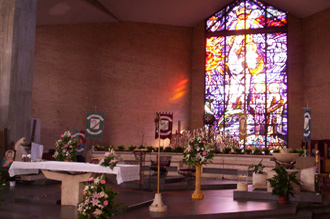 In 1975 the lateral walls were enriched by a series of eight big paintings by the painter Benedetto De Santis which represent some episodes taken from the Gospel.
In 1975 the lateral walls were enriched by a series of eight big paintings by the painter Benedetto De Santis which represent some episodes taken from the Gospel.The presbytery was completely restructured in the 80s.
It is composed of the tabernacle (embedded in a sculpture representing the world dominated by an image of Christ named “Christ of the Mountain”), of the celebrant chair, the pulpit, the baptismal font and the altar.
At the rear part of the tabernacle a small space has been kept for relics.
All the bronze works in the church are unique and original pieces of art and have been made just for our church by the artist Giorgio Fiordelli.
 Up above, on the lantern other two double stained-glass windows embellish our church. They are also by Benedetto De Santis and in them four episodes about our Lady are represented.
Up above, on the lantern other two double stained-glass windows embellish our church. They are also by Benedetto De Santis and in them four episodes about our Lady are represented.The big stained-glass window on the apse, which measures 12.49 x 6 metres, has an important artistic value.
It shows our Lady, Queen of the world and Mother of mount Carmel with the image of the book of the Apocalypse: the woman dressed of sun, with the moon at her feet and a crown of twelve stars on her head; at one side, St. Elias the Prophet, who inspired the Carmelite order, who holds in his hands a sword of fire, and on the other one St. Simon Stock, the saint who received the scapular from Mary. It was realised by Prof. Laura Giuliani Redini.
In 1993 some restoration works were done in the church: two modern and functional rooms for the confessions were built; also a portal made in glass with a TAU on it was built, two holy-water fonts made in copper and a small chapel for our Lady and the Saints.
A big statue of Christ on the cross, owned previously by Mons. Ricci, has been placed on the right walls of the church in 1997. The statue has been modelled in an extraordinary way from studies led on the Holy Shroud.
In 2006 the daily chapel was completely restored.
OUR AREA
Our parish is in the Torre Spaccata suburb (south-east of Rome); the address to visit us at is: Via Alessandro Barbosi, 6 – 00169, Rome (Italy).This is also the main entrance of the Parish House and of the Convent, while the main entrance to the church is on Via Augusto Lupi. Other useful contacts to get in touch with us are the following:
phone (+39) 06263798, fax (+39) 0623269025 and email parrocchia@mariareginamundi.org
The name of the area Torre Spaccata derives from a ruined tower on the east border of the area; this name appears in the original file of the parish (vulgo dicta “Torrespaccata”); the first nucleus of the area was inaugurated on August 15th 1961 thanks to the “Piano Fanfani” by INA-CASA, a urban plan for the city of Rome.
The area was planned and built as a “residential popular area” with solid urban criteria: many green areas, many gardens along the streets and in the courtyards and most of the buildings don’t reach more than 3-4 floors.
All the streets of the area are names after people who have bound their names to the Roman culture, converging on the main road of the area: Viale dei Romanisti. The “Romanisti” are scholars of the Roman traditions and culture. The streets are named after Roman poets such as Adone Finardi, Giuseppe Berneri, Alessandro Barbosi, Camillo Peresio, Pietro Sommariva or after main characters of the popular Roman culture, like come Rugantino and Sor Capanna.
THE PASTORAL PROGRAMME
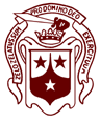
The pastoral activities in the parish are many thanks to the variety of groups, associations and movements which have found in the parish, a fertile field in which to grow.
Each group acts in a specific field; it is recognisable and it acts in a complex programme which changes every year and which defines the pastoral objectives to reach.
The programme covers the liturgy, the catechesis, deaconship, youth pastoral, missionary activities, family pastoral, in communion with the Church of Rome and its Bishop, the Pope.
The heart of the pastoral programme is the theme of the education, with a special attention paid to the families and to the youngest generations.
To educate someone in the Faith, in the Hope, in the Charity of our Lord Jesus, following his example, to form someone to be an active witness of Jesus with his works and deeds seems harder nowadays, it sometimes seems too difficult for us, but also necessary and urgent, particularly for the new generations and for the more engaged Christians and for all people who wish to accept and to live the gift of the faith for real.
Our community wants to work on this duty in this way:
- the family pastoral meetings with many initiatives which have at the heart of their interest families and young people who are planning to get married, forming young people to love already during the preparation for Confirmation and in the youth groups;
- the youth pastoral meetings, that is the attention to the adolescents’ and young people’s world for their human and spiritual growth, to help their personal relationship with Jesus Christ;
- the ordinary missionarity: to be missionaries not only to the big occasions or in the initiatives for the “Third World”, but also to adopt this way of living in our parish ordinary life; we need to move from a “sheep-fold pastoral” to a “graze pastoral”;
- the charisma of the Carmelite, is experienced and lived in communion with the big Carmelite family; it is shown every day in our way of living and in our pastoral behaviour which gives to all our initiatives a Carmelite peculiarity;
- the spiritual education of all the operators of our parish (animators of the catechesis, of the liturgy and of charity) and of everybody who belongs to the parish groups for a unified path of spiritual education;
- and finally the deaconship: for who we almost forgot, for people who really needs our help, aided by an efficient coordination of interventions to avoid the disillusionment and to give a sense of unity to the involvement in the community.
THE PARISH CHURCH WEBSITE
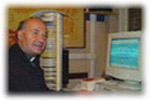 From January 1st, 2001 our parish church has a website which has been designed and set up by Father Lucio Maria Zappatore (the actual parish priest).
From January 1st, 2001 our parish church has a website which has been designed and set up by Father Lucio Maria Zappatore (the actual parish priest).Since 2005 the parish priest has been joined by a small webteam who up-date the website in a more complete and constant way.
On December 3rd 2006 a new version – the one that you see now – was published.
While designing the website we tried to make it as accessible and usable as we could in order to be able to surf it in different contexts according to what is established by the website building normative.
The website contents are written in the XHTML 1.0 strict, while the visual presentations are totally based on the Cascading Style Sheets; both the codes are validated by automatic and semi-automatic systems.
For a catholic website which aims to communicate the Faith experience of its community and which aims to be an evangelization tool, the access to the different pages is not just a technical issues but it’s a pastoral choice. It is based on a “all for all” principle.
THE SITEMAP AND ITS CONTENTS
The parish church website has five sections:- THE PARISH CHURCH - PARROCCHIA
- ACTIVITIES - ATTIVITA’
- SPIRITUALITY - SPIRITUALITA’
- CULTURE - CULTURA
- WEB - WEB
In the PARROCCHIA section you can find more detailed news and pictures about the identity of the parish community: about us, where we are (and how to reach us), who are the friars, who are part of it, the actual cardinal, and the nuns who live in the area.
What the building looks like, its art works and the relics kept in it.
We are also recovering from the history episodes and indicative images of the parish life.
- about us and where we are - chi e dove siamo
- Torre Spaccata area - il quartiere di Torre Spaccata
- the religious community, the actual cardinal, the nuns - la comuità religiosa, il cardinale, le suore
- the building and the art works - l'edificio e le opere d'arte presenti
- relics in our church - le reliquie custodite nella chiesa
- history notes - pillole di storia
In the ATTIVITA’ section we have gathered all the news about the daily life of our parish with the annual pastoral programme, the weekly announcements and appointments, the timetables and the services, the groups, the associations and the various active movements and the parish current events with the most significant happenings.
- weekly announcement and appointments - gli avvisi settimanali e la liturgia quotidiana
- the pastoral programme - il programma pastorale
- timetables and services - gli orari e i servizi
- parish current events - le cronache parrocchiali
- groups, associations, movements - i gruppi, le associazioni e i movimenti
In the SPIRITUALITA’ section wants to give space to the Word of God, to the liturgy, to the prayer and to pay tribute the Carmelite order, to its most important figures and make people know the devotion for them.
- the liturgics year: God’s time and men’s time - il tempo liturgico
- school of prayer - la scuola di preghiera
- lectio divina - la lectio divina
- the carmelite order - il carmelo
- the great carmelite figures - grandi figure carmelitane
- history of the carmelite devotion - la devozione carmelitana
We hope that the presence of the CULTURA section doesn’t sound strange in a parish church website: our music association has enriched us with many liturgical songs and our parish priest’s passion for the Roman dialect are the main reasons of our particular attention to the sonnets and the rhymes.
A forum completes this section. In this section we invite our visitors to discuss about current topic issues.
- the liturgical songs - i canti liturgici
- the publications - le pubblicazioni
- semo romani: writings in roman dialect - semo romani: scritti in dialetto romanesco
- Torre Spaccata’s streets - le strade di Torre Spaccata
- primo piano: a forum to discuss and think - primo piano: un forum per discutere e confrontarsi
In the WEB section all the important files which are useful to explain how and why we chose to design this website, it suggests some useful links for visiting it, it offers the monthly statistics of access to the website and the choice to subscribe to our weekly newsletter.
- why this website - perchè questo sito
- the webteam and the web accessibility - il webteam e l'accessibilità
- website statistics - le statistiche del sito
- map and search - la mappa e il motore di ricerca del sito
- suggested links - i link suggeriti
- the newsletter - la newsletter
Thanks for visiting us. Last up-date: March 1st, 2009
Our thanks for the translation into English go to Francesca Magnoni and, especially, to Alan Duggan.
Tel. (39) 06 263798 - Fax (39) 06 23269025 - parrocchia@mariareginamundi.org